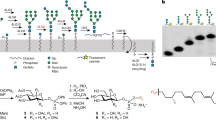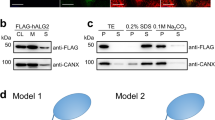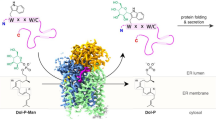Abstract
In eukaryotes, a nascent peptide entering the endoplasmic reticulum (ER) is scanned by two Sec61 translocon-associated large membrane machines for protein N-glycosylation and protein O-mannosylation, respectively. While the structure of the eight-protein oligosaccharyltransferase complex has been determined recently, the structures of mannosyltransferases of the PMT family, which are an integral part of ER protein homeostasis, are still unknown. Here we report cryo-EM structures of the Saccharomyces cerevisiae Pmt1−Pmt2 complex bound to a donor and an acceptor peptide at 3.2-Å resolution, showing that each subunit contains 11 transmembrane helices and a lumenal β-trefoil fold termed the MIR domain. The structures reveal the substrate recognition model and confirm an inverting mannosyl-transferring reaction mechanism by the enzyme complex. Furthermore, we found that the transmembrane domains of Pmt1 and Pmt2 share a structural fold with the catalytic subunits of oligosaccharyltransferases, confirming a previously proposed evolutionary relationship between protein O-mannosylation and protein N-glycosylation.
This is a preview of subscription content, access via your institution
Access options
Access Nature and 54 other Nature Portfolio journals
Get Nature+, our best-value online-access subscription
$29.99 / 30 days
cancel any time
Subscribe to this journal
Receive 12 print issues and online access
$189.00 per year
only $15.75 per issue
Buy this article
- Purchase on Springer Link
- Instant access to full article PDF
Prices may be subject to local taxes which are calculated during checkout





Similar content being viewed by others
Data availability
The cryo-EM 3D maps of the S. cerevisiae Pmt1–Pmt2 alone or complexed with the acceptor peptide have been deposited at the EMDB database with accession codes EMD-20240 and EMD-20236, respectively. Their corresponding atomic models were deposited at the RCSB PDB with accession codes 6P2R and 6P25, respectively. The crystal structure of the Pmt2 MIR domain was deposited at the RCSB PDB with accession code 6P28.
References
Panin, V. M. & Wells, L. Protein O-mannosylation in metazoan organisms. Curr. Protoc. Protein Sci. 75, 12.2.1–12.2.19 (2014).
VanderVen, B. C., Harder, J. D., Crick, D. C. & Belisle, J. T. Export-mediated assembly of mycobacterial glycoproteins parallels eukaryotic pathways. Science 309, 941–943 (2005).
Xu, C., Wang, S., Thibault, G. & Ng, D. T. Futile protein folding cycles in the ER are terminated by the unfolded protein O-mannosylation pathway. Science 340, 978–981 (2013).
Loibl, M. & Strahl, S. Protein O-mannosylation: what we have learned from baker’s yeast. Biochim. Biophys. Acta 1833, 2438–2446 (2013).
Burda, P. & Aebi, M. The dolichol pathway of N-linked glycosylation. Biochim. Biophys. Acta 1426, 239–257 (1999).
Maeda, Y. & Kinoshita, T. Dolichol-phosphate mannose synthase: structure, function and regulation. Biochim. Biophys. Acta 1780, 861–868 (2008).
Hirschberg, C. B. & Snider, M. D. Topography of glycosylation in the rough endoplasmic reticulum and Golgi apparatus. Annu. Rev. Biochem 56, 63–87 (1987).
Schwarz, F. & Aebi, M. Mechanisms and principles of N-linked protein glycosylation. Curr. Opin. Struct. Biol. 21, 576–582 (2011).
Bai, L., . & Li, H. Cryo-EM is uncovering the mechanism of eukaryotic protein N-glycosylation. FEBS J. 286, 1638–1644 (2019).
Gloster, T. M. Advances in understanding glycosyltransferases from a structural perspective. Curr. Opin. Struct. Biol. 28, 131–141 (2014).
Aebi, M. N-linked protein glycosylation in the ER. Biochim. Biophys. Acta 1833, 2430–2437 (2013).
Loibl, M. et al. Protein O-mannosyltransferases associate with the translocon to modify translocating polypeptide chains. J. Biol. Chem. 289, 8599–8611 (2014).
Neubert, P. & Strahl, S. Protein O-mannosylation in the early secretory pathway. Curr. Opin. Cell Biol. 41, 100–108 (2016).
Ecker, M. et al. O-mannosylation precedes and potentially controls the N-glycosylation of a yeast cell wall glycoprotein. EMBO Rep. 4, 628–632 (2003).
Lommel, M., Schott, A., Jank, T., Hofmann, V. & Strahl, S. A conserved acidic motif is crucial for enzymatic activity of protein O-mannosyltransferases. J. Biol. Chem. 286, 39768–39775 (2011).
Lombard, J. The multiple evolutionary origins of the eukaryotic N-glycosylation pathway. Biol. Direct 11, 36 (2016).
Dobson, C. M., Hempel, S. J., Stalnaker, S. H., Stuart, R. & Wells, L. O-Mannosylation and human disease. Cell Mol. Life Sci. 70, 2849–2857 (2013).
Immervoll, T., Gentzsch, M. & Tanner, W. PMT3 and PMT4, two new members of the protein-O-mannosyltransferase gene family of Saccharomyces cerevisiae. Yeast 11, 1345–1351 (1995).
Gentzsch, M. & Tanner, W. The PMT gene family: protein O-glycosylation in Saccharomyces cerevisiae is vital. EMBO J. 15, 5752–5759 (1996).
Lehle, L. & Tanner, W. Glycosyl transfer from dolichyl phosphate sugars to endogenous and exogenous glycoprotein acceptors in yeast. Eur. J. Biochem. 83, 563–570 (1978).
Strahl-Bolsinger, S. & Tanner, W. Protein O-glycosylation in Saccharomyces cerevisiae. Purification and characterization of the dolichyl-phosphate-d-mannose-protein O-d-mannosyltransferase. Eur. J. Biochem. 196, 185–190 (1991).
Ponting, C. P. Novel repeats in ryanodine and IP3 receptors and protein O-mannosyltransferases. Trends Biochem. Sci. 25, 48–50 (2000).
Girrbach, V., Zeller, T., Priesmeier, M. & Strahl-Bolsinger, S. Structure-function analysis of the dolichyl phosphate-mannose: protein O-mannosyltransferase ScPmt1p. J. Biol. Chem. 275, 19288–19296 (2000).
Manya, H., Akasaka-Manya, K., Nakajima, A., Kawakita, M. & Endo, T. Role of N-glycans in maintaining the activity of protein O-mannosyltransferases POMT1 and POMT2. J. Biochem 147, 337–344 (2010).
Jung, P. & Tanner, W. Identification of the lipid intermediate in yeast mannan biosynthesis. Eur. J. Biochem. 37, 1–6 (1973).
Gandini, R., Reichenbach, T., Tan, T. C. & Divne, C. Structural basis for dolichylphosphate mannose biosynthesis. Nat. Commun. 8, 120 (2017).
Holm, L. & Laakso, L. M. Dali server update. Nucleic Acids Res. 44, W351–W355 (2016).
Napiorkowska, M. et al. Molecular basis of lipid-linked oligosaccharide recognition and processing by bacterial oligosaccharyltransferase. Nat. Struct. Mol. Biol. 24, 1100–1106 (2017).
Matsumoto, S. et al. Crystal structures of an archaeal oligosaccharyltransferase provide insights into the catalytic cycle of N-linked protein glycosylation. Proc. Natl Acad. Sci. USA 110, 17868–17873 (2013).
Bai, L., Wang, T., Zhao, G., Kovach, A. & Li, H. The atomic structure of a eukaryotic oligosaccharyltransferase complex. Nature 555, 328–333 (2018).
Wild, R. et al. Structure of the yeast oligosaccharyltransferase complex gives insight into eukaryotic N-glycosylation. Science 359, 545–550 (2018).
Lizak, C., Gerber, S., Numao, S., Aebi, M. & Locher, K. P. X-ray structure of a bacterial oligosaccharyltransferase. Nature 474, 350–355 (2011).
Braunger, K. et al. Structural basis for coupling protein transport and N-glycosylation at the mammalian endoplasmic reticulum. Science 360, 215–219 (2018).
Unligil, U. M. & Rini, J. M. Glycosyltransferase structure and mechanism. Curr. Opin. Struct. Biol. 10, 510–517 (2000).
Lairson, L. L., Henrissat, B., Davies, G. J. & Withers, S. G. Glycosyltransferases: structures, functions, and mechanisms. Annu. Rev. Biochem. 77, 521–555 (2008).
Breton, C., Fournel-Gigleux, S. & Palcic, M. M. Recent structures, evolution and mechanisms of glycosyltransferases. Curr. Opin. Struct. Biol. 22, 540–549 (2012).
Sinnott, M. L. Catalytic mechanism of enzymic glycosyl transfer. Chem. Rev. 90, 1171–1202 (1990).
Zhang, L. & Ten Hagen, K. G. O-Linked glycosylation in Drosophila melanogaster. Curr. Opin. Struct. Biol. 56, 139–145 (2019).
Cheng, Y. Membrane protein structural biology in the era of single particle cryo-EM. Curr. Opin. Struct. Biol. 52, 58–63 (2018).
Lommel, M. & Strahl, S. Protein O-mannosylation: conserved from bacteria to humans. Glycobiology 19, 816–828 (2009).
Yoshida-Moriguchi, T. et al. O-mannosyl phosphorylation of alpha-dystroglycan is required for laminin binding. Science 327, 88–92 (2010).
Yang, H. et al. Analysis of phenotype, enzyme activity and genotype of Chinese patients with POMT1 mutation. J. Hum. Genet. 61, 753–759 (2016).
Chong, Y. K. et al. Dystroglycanopathy with two novel POMT1 mutations in a Chinese boy with developmental delay and muscular dystrophy. Eur. J. Paediatr. Neurol. 18, 532–535 (2014).
Bello, L. et al. Cardiomyopathy in patients with POMT1-related congenital and limb-girdle muscular dystrophy. Eur. J. Hum. Genet. 20, 1234–1239 (2012).
van Reeuwijk, J. et al. The expanding phenotype of POMT1 mutations: from Walker–Warburg syndrome to congenital muscular dystrophy, microcephaly, and mental retardation. Hum. Mutat. 27, 453–459 (2006).
Johnson, K. et al. Detection of variants in dystroglycanopathy-associated genes through the application of targeted whole-exome sequencing analysis to a large cohort of patients with unexplained limb-girdle muscle weakness. Skelet. Muscle 8, 23 (2018).
Beltran-Valero de Bernabe, D. et al. Mutations in the O-mannosyltransferase gene POMT1 give rise to the severe neuronal migration disorder Walker–Warburg syndrome. Am. J. Hum. Genet. 71, 1033–1043 (2002).
Hu, P., Yuan, L. & Deng, H. Molecular genetics of the POMT1-related muscular dystrophy-dystroglycanopathies. Mutat. Res. 778, 45–50 (2018).
Balci, B. et al. An autosomal recessive limb girdle muscular dystrophy (LGMD2) with mild mental retardation is allelic to Walker–Warburg syndrome (WWS) caused by a mutation in the POMT1 gene. Neuromuscul. Disord. 15, 271–275 (2005).
Snoei, J. et al. Genetic alterations of protein-o-mannosyltransferase-1 in glioneuronal and glial brain tumors with subarachnoid spread. Neuropathology 29, 116–124 (2009).
Currier, S. C. et al. Mutations in POMT1 are found in a minority of patients with Walker–Warburg syndrome. Am. J. Med. Genet. A 133A, 53–57 (2005).
Cotarelo, R. P. et al. A double homozygous mutation in the POMT1 gene involving exon skipping gives rise to Walker–Warburg syndrome in two Spanish Gypsy families. Clin. Genet. 76, 108–112 (2009).
Mercuri, E. et al. Congenital muscular dystrophies with defective glycosylation of dystroglycan: a population study. Neurology 72, 1802–1809 (2009).
Messina, S. et al. POMT1 and POMT2 mutations in CMD patients: a multicentric Italian study. Neuromuscul. Disord. 18, 565–571 (2008).
Chen, C., Mei, S., Zhu, C., Ren, Y. & Kong, X. [Analysis of POMT1 gene mutation in a pedigree affected with congenital muscular dystrophy]. Zhonghua Yi Xue Yi Chuan Xue Za Zhi 35, 78–80 (2018).
Manya, H. et al. Protein O-mannosyltransferase activities in lymphoblasts from patients with alpha-dystroglycanopathies. Neuromuscul. Disord. 18, 45–51 (2008).
Hafner, P. et al. Skeletal muscle MRI of the lower limbs in congenital muscular dystrophy patients with novel POMT1 and POMT2 mutations. Neuromuscul. Disord. 24, 321–324 (2014).
Yanagisawa, A. et al. POMT2 intragenic deletions and splicing abnormalities causing congenital muscular dystrophy with mental retardation. Eur. J. Med. Genet. 52, 201–206 (2009).
Biancheri, R. et al. POMT2 gene mutation in limb-girdle muscular dystrophy with inflammatory changes. Biochem. Biophys. Res. Commun. 363, 1033–1037 (2007).
Murakami, T. et al. A novel POMT2 mutation causes mild congenital muscular dystrophy with normal brain MRI. Brain Dev. 31, 465–468 (2009).
Abdullah, S. et al. Noncompaction cardiomyopathy in an infant with Walker–Warburg syndrome. Am. J. Med. Genet. A 173, 3082–3086 (2017).
Brun, B. N. et al. Uniparental disomy unveils a novel recessive mutation in POMT2. Neuromuscul. Disord. 28, 592–596 (2018).
Nabhan, M. M. et al. Cystic kidneys in fetal Walker–Warburg syndrome with POMT2 mutation: intrafamilial phenotypic variability in four siblings and review of literature. Am. J. Med. Genet. A 173, 2697–2702 (2017).
Yanagisawa, A. et al. New POMT2 mutations causing congenital muscular dystrophy: identification of a founder mutation. Neurology 69, 1254–1260 (2007).
Martinez, H. R. et al. Novel cardiovascular findings in association with a POMT2 mutation: three siblings with alpha-dystroglycanopathy. Eur. J. Hum. Genet. 22, 486–491 (2014).
Grahn, E. et al. Crystal structure of the Marasmius oreades mushroom lectin in complex with a xenotransplantation epitope. J. Mol. Biol. 369, 710–721 (2007).
Otwinowski, Z. & Minor, W. Processing of X-ray diffraction data collected in oscillation mode. Methods Enzymol. 276, 307–326 (1997).
Adams, P. D. et al. PHENIX: a comprehensive Python-based system for macromolecular structure solution. Acta Crystallogr. D 66, 213–221 (2010).
Emsley, P., Lohkamp, B., Scott, W. G. & Cowtan, K. Features and development of Coot. Acta Crystallogr. D 66, 486–501 (2010).
Murshudov, G. N., Vagin, A. A. & Dodson, E. J. Refinement of macromolecular structures by the maximum-likelihood method. Acta Crystallogr. D 53, 240–255 (1997).
Zheng, S. Q. et al. MotionCor2: anisotropic correction of beam-induced motion for improved cryo-electron microscopy. Nat. Methods 14, 331–332 (2017).
Mindell, J. A. & Grigorieff, N. Accurate determination of local defocus and specimen tilt in electron microscopy. J. Struct. Biol. 142, 334–347 (2003).
Zivanov, J. et al. New tools for automated high-resolution cryo-EM structure determination in RELION-3. Elife 7, e42166 (2018).
Chen, V. B. et al. MolProbity: all-atom structure validation for macromolecular crystallography. Acta Crystallogr. D 66, 12–21 (2010).
Pettersen, E. F. et al. UCSF Chimera–a visualization system for exploratory research and analysis. J. Comput. Chem. 25, 1605–1612 (2004).
Acknowledgements
We thank G. Li for advice on constructing yeast strains and D. Nadziejka for critical reading of the manuscript. Cryo-EM data were collected at the David Van Andel Advanced Cryo-Electron Microscopy Suite at Van Andel Research Institute. We thank G. Zhao and X. Meng for assistance in data collection. This work was supported by the U.S. National Institutes of Health grant no. R01 CA231466 (to H.L.). X-ray diffraction data were collected at the Life Sciences Collaborative Access Team (LS-CAT) beamline at the Advanced Photon Source, which was supported by the Michigan Economic Development Corporation and the Michigan Technology Tri-Corridor (Grant no. 085P1000817).
Author information
Authors and Affiliations
Contributions
L.B. and H.L. designed experiments. L.B. carried out most of the experiments. A. Kovach, Q.Y. and A. Kenny participated in sample preparation. L.B. and H.L. analyzed the data and wrote the manuscript.
Corresponding author
Ethics declarations
Competing Interests
The authors declare no competing interests.
Additional information
Peer review information: Katarzyna Marcinkiewicz was the primary editor on this article and managed its editorial process and peer review in collaboration with the rest of the editorial team.
Publisher’s note: Springer Nature remains neutral with regard to jurisdictional claims in published maps and institutional affiliations.
Integrated supplementary information
Supplementary Figure 1 Cryo-EM 3D density map of the Pmt1−Pmt2−peptide complex and comparison with 3D map of the Pmt1−Pmt2 complex.
(A) 3D map of the Pmt1−Pmt2−peptide complex surface-rendered and shown in a front, a back, a top, and a side-on view. Light green shows the transmembrane region of Pmt1; green, the MIR domain of Pmt1; purple-blue, the transmembrane region of Pmt2; and purple, the MIR domain of Pmt2. Sugar donor and peptide acceptor are orange and orange-red, respectively. The two N-glycans and three phospholipids are in red and gray, respectively. (B) 3D map of the as-purified Pmt1–Pmt2 complex is surface-rendered and shown as gray in a top view. (C) Surface-rendered 3D map of the Pmt1–Pmt2–peptide shown in yellow and in the same top view as in (B). (D) The two 3D maps are superimposed and shown in the same top view as in (A). (E) Zoomed views of the areas in the black and orange squares in (B) and (C), respectively. The extra density from the model acceptor peptide is orange-red in (C) and (D). The surface-rendering threshold in (E) is slightly lower than those used in (B-D), to show the continuous peptide density.
Supplementary Figure 2
3D density map and atomic model of selected regions in the structure of the Pmt1–Pmt2–peptide complex.
Supplementary Figure 3 Crystal structure of the MIR domain of Pmt2.
(A) Gel filtration of the MIR domain of Pmt2. The inset shows the SDS-PAGE gel of the five fractions collected around the filtration peak (shown by the horizontal arrow). (B) 3D electron density map and atomic model of a selected region. (C) Overall structure of the MIR domain of Pmt2 shown in a top, bottom, and side views. The structure contains three repeats of the MIR motif, each of which has four β-strands and one short α-helix. The numbers refer to the β-strand number in the β-trefoil fold. All residues in the Pmt2 MIR domain (amino acids 337-532) are resolved (i.e., no residues are missing in the crystal structure).
Supplementary Figure 4 Superposition of Pmt1 and Pmt2 structures.
(A) Superposition of the transmembrane regions of Pmt1 (green) and Pmt2 (purple). Dol-P in Pmt1 is in orange sticks, and the acceptor peptide in Pmt2 is in red spheres. (B) Superposition of the MIR domains of Pmt1 (green) and Pmt2 (purple). (C) Superposition of Pmt1 and Pmt2, aligned by their transmembrane regions, showing the displaced orientation and location of their respective MIR domains. Pmt1 is show in green carton and as a transparent green surface. Pmt2 is shown only in blue for clarity. The curved arrow indicates the relative movement of about 13 Å and rotation of about 17° between the MIR domains of Pmt1 and Pmt2.
Supplementary Figure 5 Comparison of the Dol-P binding site in S. cerevisiae Pmt1−Pmt2 complex (A) with the donor binding site in the archaeal Pyrococcus furiosus DPMS (B) and superposition of the MIR domain of Pmt2 (purple) and the sugar-bound lectin (salmon) (C).
(A) A close-up view of the active site of Pmt1. The phosphate group of the donor Dol-P-Man is marked by a yellow asterisk. The mannose is missing in our density map; but its likely position is shown as a dashed red hexagon. (B) A close-up view of the active site of the product (Dol-P-Man) bound DPMS structure (PDB 5MM1). The phosphate group of Dol-P is marked by a yellow asterisk. (C) The lectin (PDB ID 2IHO) has an N-terminal β-trefoil fold domain and a C-terminal dimerization domain. The lectin structure is in complex with the trisaccharide Gal(1,3)Gal(1,4)GlcNAc. For clarity, only the β-trefoil fold bound to the sugar (in red spheres) is shown. The Dol-P bound to the Pmt1 (green) is also shown in red spheres.
Supplementary information
Supplementary Information
Supplementary Figs. 1–5, Supplementary Table 1 and Supplementary Notes 1–4
Supplementary Video 1
Cryo-EM 3D density map of Pmt1−Pmt2−acceptor peptide is rotated 360°, first around a vertical axis, followed up another 360° rotation around a horizontal axis. The Pmt1 density is in green and Pmt2 is in purple. Their respective MIR domains are a slightly stronger shade. The product density Dol-P is orange, and the two glycans are red.
Supplementary Video 2
Nutation of the active site of Pmt1. Pmt1 is in green, the model acceptor peptide in red and Dol-P in orange. Key residues in the active site are shown as sticks
Rights and permissions
About this article
Cite this article
Bai, L., Kovach, A., You, Q. et al. Structure of the eukaryotic protein O-mannosyltransferase Pmt1−Pmt2 complex. Nat Struct Mol Biol 26, 704–711 (2019). https://doi.org/10.1038/s41594-019-0262-6
Received:
Accepted:
Published:
Issue Date:
DOI: https://doi.org/10.1038/s41594-019-0262-6
This article is cited by
-
Structure, sequon recognition and mechanism of tryptophan C-mannosyltransferase
Nature Chemical Biology (2023)
-
Conserved sequence motifs in human TMTC1, TMTC2, TMTC3, and TMTC4, new O-mannosyltransferases from the GT-C/PMT clan, are rationalized as ligand binding sites
Biology Direct (2021)
-
Structure and mechanism of the ER-based glucosyltransferase ALG6
Nature (2020)
-
Cryo-EM structure of arabinosyltransferase EmbB from Mycobacterium smegmatis
Nature Communications (2020)



